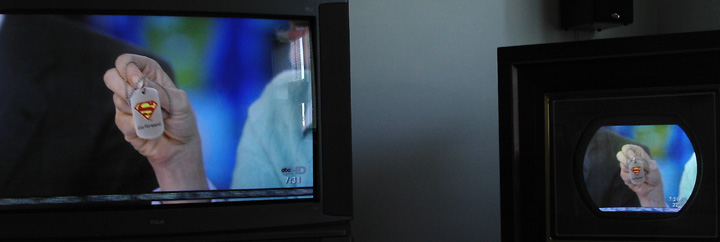THE SETRestoration Log
10-30-2005 I’ve been working on the restored CT-100 recently to prep it for display in my living room. After extensive tuning and testing, got it buttoned up a few days ago, including the screen under the chassis, a small fan near the back to aid in dispelling heat, and wood screws in the back cover.
I cleaned and polished the mahogany veneer, bolted the chassis to the cabinet, tightened four wing nuts that lock the cabinet lid, and then turned it on and damn, three minutes later the screen went dim. Remove the back, then troubleshoot to find the second video amplifier (a 6AN8) causing the headache. Pitch it in the trash. Put in a replacement. Button it all up again. Get out the NOS fine tuning knob I’ve been saving for this occasion and, after first testing the installation procedure on a spare CTC-2 chassis, crack the plastic on the new knob trying to install it on the restored chassis. Cuss. Mix some epoxy. Stick it back together, and use a worn knob for now. Okay, all this sets the stage for what I’ve been working for since 1999, but intensely since last April: eyeball 1953 NTSC color! I think it happened. After mocking the WB earlier on AudioKarma, WPIX channel 11 came through with (pun intended of course) flying colors! South Park. Never watched it. Some of my thirty-something acquaintances love to quote it. Don’t care about it. But what color! Chrominance charts indicate the extended green capability of the 1953 standard. My eyes believe the green on the character’s hat is in that extended area of the 1953 spec. A simultaneous display of the program on a high-definition direct-view CRT receiver in the NTSC mode was strikingly less vibrant. The HDTV served as a standard — a stable source of color used in the initial alignment of the color AFC circuits of the CT-100, for example. During the past several weeks, I would adjust the CT-100 to match the colors of the HD set. Not the brightness of course, but particularly subtle pastels and varying hues of violet. It’s a darn fine HD television set. But for this experience, which reproduces a program on two different sets driven from the same antenna, the HD set displayed completely lackluster green hues for that character’s hat compared to the CT-100.  Yellow was also visually different. A suggestion of which appears as this guy’s mittens seen above and below.
 12-09-2005 As noted above in the 10-30-2005 entry, I continue to work on the restored CT-100. After additional adjustment it appears that the green may have been out of balance in the above presentation. The next photo, with the ATSC set operating in the NTSC mode, shows a better green balance and is in keeping with the current improvement in hue match between the sets.  A photo of the sets closer together was taken weeks earlier after this latest alignment. In the example, the comparison is between a wide-screen HD channel and its analog channel equivalent on the CT-100.

|



